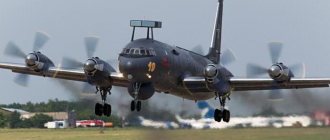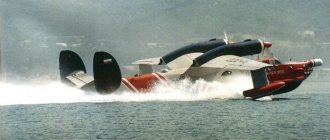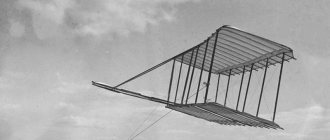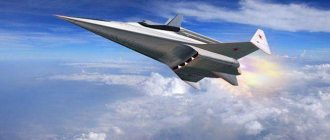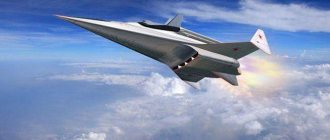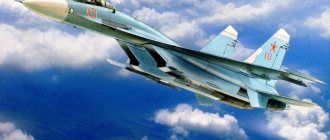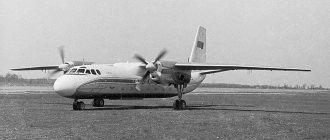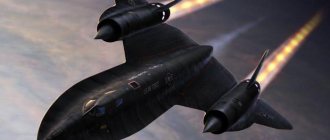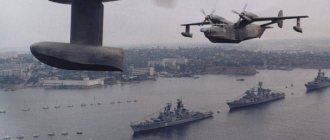Basic patrol aircraft P-3 "Orion"
Created in the late 50s, the BPA (basic patrol aircraft) P-3 Orion aircraft is one of those types of aircraft that are considered to be “eternal.”
Its progenitor appeared in 1957, when Lockheed produced the L-188 Electra, one of the first aircraft in the United States with a turboprop engine. It was also one of the few American turboprop passenger aircraft to be mass produced. A total of 170 civil aircraft of this type were produced, of which approximately 20 are still flying today.
Lockheed L-188 Electra
In 1957, the United States Navy announced a competition to develop a modern maritime patrol aircraft, which was to replace the P-2 Neptune.
Lockheed P-2H "Neptune"
The prototype, designated P3V-1, flew on November 25, 1959, and the first production prototype, P3V-1, took off on April 15, 1961. The aircraft later received the designation P-3 Orion. Compared to the L-188, the P-3 had a fuselage that was 2.24 meters shorter. A weapons bay was added and new aircraft equipment was installed. The weapons compartment was designed to accommodate torpedoes, depth charges, mines, or nuclear weapons. The aircraft also had 10 pylons under the planes for the external suspension of various weapons.
On the Orion, compared to the Electra, the cockpit was redesigned to improve forward visibility. Unlike the progenitor of the L-188, the Orion's fuselage was divided horizontally by a deck and there were no passenger windows. In the upper part there was a sealed cabin with a volume of 195 cubic meters, which made it possible to create comfortable conditions for operators and place in it the main units of anti-submarine equipment, radio-hydroacoustic search equipment, and communications equipment. Thus, the crew gained access to many pieces of equipment and the ability to troubleshoot some problems in flight, as well as manually reload four of the 52 buoy launchers. The latter are discharged using pyrotechnic devices.
Anti-submarine equipment consisted of radio-acoustic systems: active “Julie”, which uses explosive charges as a source of acoustic energy and subsequently receives signals reflected from the target; and the passive Jezebel, which uses passive low-frequency buoys. An aircraft magnetometer, a Snifer gas analyzer, and two radars were also installed. It was possible to hang 4 anti-submarine homing torpedoes, depth charges and other weapons.
The plane's crew consisted of ten people. Responsibility for the integrated use of means and making tactical decisions appropriate to the tasks and situation was assigned to the tactical coordination officer. According to the current regulations, the crew commander was responsible for the completion of the mission and flight safety.
The aircraft had good maneuverability characteristics, its search speed was 300-320 km/h, maximum 760 km/h, flight range up to 9000 km, duration up to 17 hours, which could be increased by turning off one or more in flight, depending on the flight weight , two engines.
The features of the R-3A aircraft compared to the Neptune patrol aircraft are its higher performance and search capabilities. The search tools on the plane were combined into a system, it was very convenient to work with the equipment in flight, the level of noise and vibration turned out to be low, and the fact that about 25% of the free volumes remained free for upgrading the equipment became of no small importance.
The Orions' combat service began in July 1962, when the first production P3V-1 was handed over to the personnel of the VP-8 patrol squadron. Following this, the Orions received VP-44 and VX-1, where they replaced the obsolete R-2 Neptune. In addition to searching for submarines, the P-3s carried out training mine laying, over-the-horizon target designation and warning in the interests of surface ships, weather reconnaissance, and coordination of search and rescue operations.
The operation of the aircraft immediately revealed the bottleneck of the search equipment - the AQA-3 system and its improved version AQA-4. Searching for submarines using acoustics was the most effective; the probability of detecting a submarine with a magnetometer was much lower, and other systems could only “detect” a boat moving on the surface or under a periscope. The “Snifer” system responded not only to the exhaust of the submarine’s diesel engines, but also to the exhaust gases of the Orion’s theater engine.
The new system for processing and analyzing information about submarines was tested on the 35th production P-3, and, starting with the 110th aircraft, it became standard. From 1962 to 1965, 157 R-3A were produced.
The active construction of a submarine fleet in the USSR and the entry of Soviet ships into the world's oceans required the improvement of American patrol forces.
The next serial modification of the Orion was the R-3B. The difference from the P-3A was the more powerful Allison T56-A-14 turboprop engines with a shaft power of 3361 kW (4910 hp) and the new Deltic system for detecting submarines. The armament included the Bullpup air-to-surface missile. A total of 144 P-3Bs were produced.
Despite the improved performance, the aircraft's acoustic equipment still did not satisfy the military. For five years, the US Navy has been conducting research to create a new automated system for data processing and control of search equipment, and not only hydroacoustic equipment. The final version of the A-NEW system also did not fully meet the objectives, however, A-NEW turned out to be the best option proposed by the industry. The platform for this complex was the next modification of the R-3S. 143 vehicles were built.
The R-3S became the world's first anti-aircraft aircraft with a centralized computer for processing information from search and navigation systems. In addition, the computer issued commands to reset the RSL and use weapons. The use of a computer and the new acoustic processor AQA-7 made it possible to dramatically increase the efficiency of the hydroacoustic complex - now information from 31 buoys was simultaneously processed, while AQA-5 made it possible to “listen” to no more than 16 buoys.
The aircraft's capabilities for detecting surface targets were expanded due to the installation of a low-level television system instead of the searchlight used on the R-3A/B and the new ARS-115 radar. Digital communications equipment made it possible to exchange information with other aircraft, ships and coastal command posts. The pilot was equipped with a tactical situation indicator. Navigation and radio communication equipment was completely updated.
During operation, the aircraft continued to be continuously improved. The onboard weapons included the Harpoon anti-ship missile system and a number of improvements related to acoustic search systems. In the early 90s, AGM-84 SLAM missiles, designed to destroy ground targets, entered service with the Orions. In addition, it became possible to hang a container with AN/ALQ-78 electronic warfare equipment on the internal underwing pylon. The result was a multi-role attack aircraft capable of autonomously searching for and hitting surface, underwater and ground targets.
In the mid-1980s, which marked the peak of the confrontation between the NATO and USSR fleets, the Orions were in service with 24 combat and one combat training squadron of US Navy aviation.
The squadrons were organized into five patrol air wings of the base aviation. Two wings were part of the Atlantic Fleet air forces and had six squadrons, the three remaining wings each had four P-3 squadrons and were part of the Pacific Fleet air forces.
As the early Orions became obsolete as anti-aircraft aircraft, they were transferred to storage at Davis-Monthan, and were also converted to perform other tasks.
There are many different versions of the aircraft: ER-ZA for testing electronic equipment, electronic “aggressor” for conducting exercises, ER-ZE “Eris” electronic reconnaissance aircraft, NP-3A/B flying laboratory, aircraft for oceanographic and geomagnetic research RP-3A/ D, training TR-ZA, transport UP-ZA/V, VP-ZA for VIP transportation and weather reconnaissance aircraft WP-3A.
ER-ZE "Eris"
Created on the basis of the P-3B, the P-3AEW AWACS aircraft, equipped with an aviation early warning and guidance system, was intended for the US Customs Service.
From June 1988 to 1993, customs officers received a total of four P-3s equipped with the AN/APS-138 radar (similar to the E-2C Hokai radar). The aircraft are used to detect, track and coordinate the interception of drug smuggling operations.
the plane AWACS P-3AEW
Four anti-submarine Orions were upgraded to the P-3A (CS) version to control US airspace in order to suppress the illegal delivery of cargo, primarily drugs, by light aircraft.
Google Earth satellite image: US Customs aircraft at an airfield in Costa Rica
The vehicles are equipped with an AN/APG-60 radar (installed in the nose of the aircraft), which has better performance in detecting air targets than the original P-3A station. In addition, radio equipment has been installed that operates on the frequencies of the US Customs Service and the US Coast Guard.
Twelve obsolete R-ZA were purchased by the US Forest Service in 1989, nine of them were transferred to Aero Union Corporation in Chico, California, for conversion into firefighting aircraft. In 2010, Aego Union operated seven P-3A/RADSIIs along with the upgraded Neptune and C-54. "Orions" have been used to extinguish fires since 1990 and have proven themselves to be an excellent firefighting agent. The aircraft’s maneuverability and high power of the power plant allow it to fly in very rough terrain and accurately drop fire extinguishing mixture.
P-3s of various modifications were transferred in significant quantities to US allies. The aircraft is in service with Argentina, Australia, Brazil, Chile, Greece, Japan, the Netherlands, New Zealand, Norway, Iran, Pakistan, Portugal, South Korea, Spain, and Thailand.
The Japanese Maritime Self-Defense Force has the second largest number of Orions in the world after the US Navy. The Orion was chosen by the Japanese to replace the Neptunes in August 1977. Having a developed aviation and electronics industry, they preferred to establish licensed production rather than purchase finished products in the USA.
The first three P-3Cs intended for the Self-Defense Forces were manufactured by Lockheed, the next five were assembled in Japan from American components, and the remaining 92 were built and equipped with equipment at .
The Orions were adopted by 10 squadrons; the last P-3C was delivered to the customer in September 1997. During the licensed production process, the Orions were repeatedly improved.
Starting with the 46th aircraft, the search radar and acoustic signal processing processor were improved, and electronic warfare equipment was installed. Nine vehicles were equipped with an automatic flight control system. From the 70th machine, the DIFAR equipment was replaced by the Proteus acoustic signal processing system from a central digital computer. Since 1989, a satellite communication system was installed, as evidenced by the black antennas in the upper front part of the fuselage. Since 1993, all radio-electronic components have been replaced on previously built Japanese R-3S.
The Japanese Maritime Self-Defense Forces have four EP-3Es in service. They entered service in 1991-98. Japanese cars are fully equipped with special equipment of national design and production. The planes were built by Kawasaki.
The Orions of Canada stand apart. In 1980-1981, Canadian naval aviation received 18 CP-140 Aurora, which was a hybrid of the P-3C airframe and the search equipment of the S-3A Viking carrier-based PLO aircraft. The SR-140 is in service with four squadrons.
Three more SR-140A Arcturus are designed to control the economic zone of the ocean shelf adjacent to the Canadian coast and protect fisheries. "Arctura" has a simplified composition of equipment, compared to "Aurora". These aircraft replaced the SR-121 Trekker patrol aircraft in 1992-1993.
"Orions", along with RC-135 and SR-71, were the most frequent "clients" and primary targets for our air defense forces. Slow-moving, capable of “hanging” in the loitering zone for hours, it literally exhausted the crews of the forces on duty. Often the flights of these violent machines are openly provocative. A number of incidents have been associated with these aircraft.
On September 13, 1987, a Norwegian P-3B Orion patrol aircraft tried to monitor a group of Soviet warships in the neutral waters of the Barents Sea. The Su-27 pilot received an order to perform a training interception of the Orion. The reconnaissance crew tried to get rid of the enemy and sharply reduced speed, believing that the fighter would not be able to stay close to it at low speed. However, the Su-27 continued to fly directly under the Orion. The Norwegian pilot lost sight of the fighter and began to maneuver. As a result, the Orion propeller hit the fin of the Su-27. The propeller collapsed, its fragments pierced the R-3B fuselage, depressurization occurred, and the Orion was forced to leave the patrol area, and the Su-27 returned safely to base.
The next time, in April 2001, Orion collided in the air with a Chinese fighter. Trying to look “further” deep into the continent, American pilots sometimes violate Chinese airspace, provoking the PLA to retaliate. In the Chinese case, the EP-3E was at the center of events, and for some reason its crew was one and a half times larger than usual.
As a result of the collision, the Chinese J-8-II interceptor fell into the sea, killing its pilot. The EP-3E was damaged and was forced to land on Hainan Island. Subsequently, the United States apologized for the incident and paid compensation to the widow of the deceased.
The car was disassembled by the Chinese for detailed study and subsequently returned to the United States in July 2001. “Orion” arrived “to its historical homeland” in the belly of the Russian An-124-100 “Ruslan” transport aircraft.
To replace the “obsolete” P-3C, the United States began developing a next-generation anti-submarine aircraft. The design of the aircraft, designated P-8A Poseidon, is based on the fuselage of the Boeing 737-800 airliner and the wing from the Boeing 737-900.
P-8A "Poseidon"
The first flight of Poseidon took place on April 25, 2009. According to the plan, in 2013 the US Navy was to receive 13 P-8A. Another 8 aircraft have been ordered by Australia and India.
Google earth satellite image: P-3C and P-8A at Jacksonville airfield
The Navy planned to purchase a total of 117 P-8A aircraft, based on the Boeing 737-800, to completely replace its entire P-3 fleet. However, apparently, this will not happen soon. Due to the high cost of the P-8A, it was announced that the procurement program would be reduced. Moreover, further improvement of the avionics of the R-3S aircraft is proposed.
Thus, the honored “veteran” P-3 Orion will remain the main patrol and anti-submarine aircraft in the USA and many other countries for a long time.
Based on materials from: https://www.aviastar.org/air/usa/lok_orion.php https://www.zelezki.ru/aviacatalog/usa https://www.aex.ru/fdocs/1/2005/12 /21/7368/
operators
military
Argentine Navy P-3B. Royal Australian Air Force P-3W in 1990. P-3ACH de la Armada de Chile. Spanish Air Force P-3A. P-3C Orion of the Japan Maritime Self-Defense Force. P-3 Orion of the Portuguese Air Force. Germany
- Marina Alemana: 8 P-3Cs
.
Base Aeronaval Nordholz, Marinefliegergeschwader 3 Graf Zeppelin
.
Argentina
- Argentine Navy: 6 P-3Bs
, none active (two units initially stored as a source of spare parts, one unit at FAdeA awaiting restoration and modernization). [ 5 ] Increase surveillance capabilities with INVAP Plates 440 . Naval Air Station Almirante Zar (BAAZ) - Trelew, Chubut Province.
Australia
- Royal Australian Air Force - 18 AP-3C
, 1
P-3C
(No. 92 Wing - 10 Squadron, 11 Squadron) and (No. 292 Squadron. RAAF Base Edinburgh.
Brazil
- Brazilian Air Force - 8 P-3AM
will be modernized in Spain and delivered from the end of 2009 to Salvador Air Base.
Canada
- Royal Canadian Air Force - 24 CP-140 Aurora (airframe from P-3 Orion
with electronic equipment from S-3 Viking).
Chile
- Chilean Navy: 4 P-3ACH
. Based at Torquemada, Carriel Sur and Guardiamarina Zanyartu airports.
South Korea
- Republic of Korea Navy - 8 P
-3C, 8
P-3CK
. Based at Pohang Airport and Jeju International Airport.
Spain
- Spanish Air Force 11th Wing, Moron Air Base: 7 aircraft; 5 R-3Bs
are undergoing modernization and 2
R-3As
.
US
- US Navy: 161 P-3C
;
additional P - 3A
,
P-3B
,
P-3C
and
EP-3J
in long-term storage at AMARC. [6] - National Oceanic and Atmospheric Administration (NOAA): 2 WP-3Ds
, manned by NOAA-commissioned corps members, based at MacDill AFB, Florida.
Greece
- Marina Griega: 6 P-3Bs
. Eleusis Air Base.
Iran
- Islamic Republic of Iran Air Force: 5 P-3Fs
(71ASW SQN). Based at Shiraz International Airport (Shahid Douran Air Base).
Japan
- Japan Maritime Self-Defense Force - 101 P-3C
, 5
EP-3
, 1
UP-3C
, 3
UP-3D
.
New Zealand
- Royal New Zealand Air Force No. 5 Squadron RNZAF Base Auckland: 6 P-3Ks
.
Norway
- Royal Norwegian Air Force 333 Squadron based at Andøya Airfield: 4 P-3Cs
, 2
P-3Ns
.
Pakistan
- Pakistan Navy: 10 P-3C
. Naval Air Station Faisal, Karachi.
Portugal
- Portuguese Air Force 601st Squadron. Beja Air Base (BA11): 6 P-3P
, 5
P-3C
.
People's Republic of China
- Republic of China Navy - 12 P-3Cs
(on order, deliveries beginning 2012); [ 7 ] Based at Taoyuan Air Base.
Thailand
- Royal Thai Navy 102 Squadron. U-Tapao Naval Air Base: 2 P-3T
, 1
VP-3T
.
Ancients
Netherlands
- Royal Netherlands Navy
Civilians
US
- NASA - The P-3B
, based at the NASA
Wallops Flight Facility
, is used to perform low-altitude scientific flights. It was a US Navy aircraft that was modified to support the instruments needed for such missions. [ 8 ] - U.S. Department of Homeland Security/Customs and Border Protection/CBP Air: 8 P-3 AEW aircraft
, based at Naval Air Stations Corpus Christi, Texas, and Jacksonville, Florida.
They are used for border patrol and anti-drug operations. These were US Navy aircraft that were modified and equipped with the same early warning (AEW) radar as the E-2 Hawkeye. [ 9 ] 8 P-3 LRT
(Long Range Tracking).
They were also from the Navy and have the same bases as the previous ones. They usually fly with R-3 AWACS
. [ 10 ] - Aero Union - 8 P-3As
formerly owned by the US Navy, based at Chico, California, converted to firefighting aircraft. [ eleven ]
Payload options
Inside the UAV ground control center. The drone “crew” includes two operators and a commander.
To carry out reconnaissance and surveillance of the terrain, the following equipment is installed on board the Orion UAV:
- Surveillance and sighting optical-electronic system. Installed on a gyro-stabilized platform located in the forward internal compartment of the fuselage. This system includes two thermal imagers, a wide-angle television camera and a laser rangefinder-target designator.
- Surveillance radar station. It is installed in the central internal compartment of the fuselage and is closed from below with a radio-transparent cap.
- High resolution aerial photography system. It is installed instead of a surveillance radar and consists of a set of digital photo and video cameras placed on a gyro-stabilized platform.
- System for collecting information about enemy air defense radars. Receives radio waves and determines the location of their sources. Installed in the central internal compartment of the fuselage.
- Electronic warfare equipment.
In addition, it is assumed that it is possible to use relay equipment with the ability to provide stable communications at distances of up to 150-200 km. The surveillance and targeting optical-electronic system is capable of automatically tracking detected targets and transmitting their coordinates to the control point.
UAV design
According to the creator of Orion, the aircraft is almost entirely made of Russian-made carbon fiber. The use of this material makes it possible to significantly reduce the weight of the drone and its visibility on radar screens.
UAV "Orion" and its chief designer, Nikolai Nikolaevich Dolzhenkov.
The Orion UAV is built according to a normal aerodynamic design. The straight, high aspect ratio wing is located approximately in the middle of the elongated narrow fuselage with an asymmetrical cross-section. The rear empennage consists of two inclined stabilizer fins, forming something like the letter V.
Immediately behind the tail the AV-115 variable pitch variable pitch propeller is located. It is controlled using an electric drive. The propeller pitch is adjusted by on-board electronics.
The chassis of the Orion UAV is three-legged, with a front rotating strut. In addition, there is a retractable stop in the tail section designed to protect the propeller from contact with the runway surface.
The Austrian Rotax 914 engine with 115 horsepower was installed as a power plant on the first prototypes of the Orions. The American MQ-1 Predator attack and reconnaissance drones were once equipped with the same engine. The standard engine of the Russian drone should be the APD-115T (original designation APD-110/120), developed at Itlan Engineering Center LLC (Rybinsk) on the basis of the same Rotax. The problems that arose during its creation are described above.
APD-115T is a piston opposed four-stroke internal combustion engine with a volume of 1.7 liters. The cooling system is combined (the cylinder jackets are cooled by the incoming air flow, and the heads are cooled by a special liquid). The maximum engine power is 120 horsepower, but in stable horizontal flight mode it produces from 70 to 90 hp.
Related aircraft
Related developments
- Lockheed P-2 Neptune
- Martin P-5 Marlin
- Lockheed L-188 Electra
- Lockheed EP-3
- Lockheed WP-3D Orion
- Lockheed SR-140 Aurora
- Lockheed R-7
Similar aircraft
- Embraer 145 AEW&C
- Bombardier DHC-8-MPA-D8
- Canadair CP-107 Argus
- HOUSE C-295 Exhorter
- Boeing P-8 Poseidon
- Boeing 737 AEW&C
- Boeing E-767
- Grumman E-2 Hawkeye
- Lockheed Martin C-130J Super Hercules
- Breguet Atlantic
- ATP 42
- Alenia C-27J Spartan
- Kawasaki P-1
- Avro Shackleton
- Hawker Siddeley Nimrod
- Saab 340 AEW&C
- Ilyushin Il-38
Notation sequences
- P_V
sequence (US Navy patrol aircraft, 1922-1962 (Lockheed (Vega), 1923-1962)): - P2V -
P3V - P-_
sequence (US patrol aircraft, 1962-present): P-2 -
P-3
- P-4 - P-5 - P-7 →
References
- Joint Task Force Odyssey Dawn Public Affairs (March 29, 2011). "US Navy P-3C, USAF A-10 and USS Barry engage Libyan ships". VMF.mil . Retrieved May 23, 2011
- "Spanish warplane prevents pirate attack in Somali waters - Nacional - Diario de Mallorca".
- "Spain thwarts pirate plans: News24: Africa: News". Archived from the original on November 1, 2008.
- "Digital video and image distribution system" (undefined).
- Bettolli, Carlos Borda (December 23, 2022). "Naval Aviation - The P-3 Orion will have to wait." . Military zone
. Retrieved July 27, 2022. - "US Area 39 P-3s". Defense news. January 11, 2008. Retrieved January 11, 2008 (broken link available at Internet Archive; see history, first and last versions).
- The US agreed to repair aircraft for Taiwan. Washington Post. 2009-03-13. Retrieved September 13, 2007
- Wikimedia Commons has media related to Wallops. Archived from the original on June 11, 2009.
- "DHS Air Assets P-3 AEW". Archived from the original on October 29, 2009.
- "DHS Air Assets P-3 LRT". Archived from the original on October 29, 2009.
- “Fire fighting” (undefined). aerounion.com.
- Wikimedia Commons has media related to Nelson Bocaranda Sardi. Archived from the original on January 23, 2010. Retrieved January 21, 2010.
- "P-3C Orion Long Range ASW". fleet.mil. February 18, 2009. Retrieved July 14, 2010
- "Specifications: P-3" (English). lockheedmartin.com. Archived from the original on July 23, 2010. Retrieved July 14, 2010
Comparison with foreign analogues
Immediately after information appeared about the adoption of the first three Orion UAVs, articles appeared in the press stating that this drone was clearly lagging behind the American MQ-9 Reaper.
Chinese UAV CH-5. Like the American Reaper, much larger in mass than Orion.
Meanwhile, such a comparison is clearly inappropriate - a car created in the USA is much larger in size and weight. That is why the Reaper is equipped with a more powerful engine and is capable of flying at altitudes of up to 15,000 meters, that is, twice as high as Orion.
The closest thing to the new Russian drone is the Turkish Bayraktar TB2 UAV. It is slightly (50 kg) inferior to Orion in terms of payload weight, having slightly smaller geometric dimensions. The Russian UAV is noticeably superior to the Bayraktar only in such a parameter as its combat radius - 250 km versus 150 km.
The Israeli drones Heron and Hermes 900 differ little from the Orion in their take-off weight. At the same time, Hermes is capable of carrying up to 300 kilograms of payload, and Heron – up to 250. In addition, these drones are capable of staying in the air much longer than the Russian aircraft. In particular, the maximum flight duration of the Hermes 900 is 46 hours. The operational ceiling of both Israeli UAVs exceeds 9000 meters, which also gives them some advantage.
On-board equipment
Surveillance and targeting optical-electronic station installed in the nose compartment of the Orion UAV.
The Orion UAV is distinguished by a very high level of control automation. In particular, during takeoff and landing, operator intervention is not required in the vast majority of cases, although this possibility itself is still retained. In general, the equipment that ensures the flight of a UAV consists of the following elements:
- Navigation system. The current location of the aircraft is determined using accelerometers and gyroscopic devices, as well as using data received via a satellite antenna by the GPS/GLONASS module.
- Communication equipment with ground control station.
- Equipment diagnostics and monitoring system
- Automatic control system.
When landing, Orion is capable of using not only a satellite navigation module, but also a special dual-band radar. If there is intense interference, a laser system may be used instead. In Syria, according to some evidence, all three automatic landing options were successfully tested.
Since, starting around 2015, Orion began to be considered not only as a reconnaissance drone, but also as an attack drone, a combat information and control system (CIUS) appeared on board, ensuring the use of high-precision weapons.
Performance characteristics
Orion can be classified as a medium-altitude UAV with a long flight duration. Its main characteristics are:
| UAV length | 8 m |
| Height | 3.2 m |
| Wingspan | 16.3 m |
| Full load takeoff weight | 1 ton |
| Payload weight | Up to 200 kg |
| Combat radius | 250 km |
| Maximum flight duration | 24 hours (according to other sources, 27 hours) |
| Operational ceiling | 7,500 m |
| Cruising speed | From 120 to 200 km/h (according to various sources) |
When using one of the Orions as a repeater, the combat radius of other UAVs increases to 300 km. There is no information yet about the maximum flight range.
UAV armament
To destroy ground targets, Orion can use guided missiles, free-falling and adjustable aerial bombs. They are placed on three hardpoints, two of which are located under the drone’s wing, and another one (central) is under its fuselage.
A small-sized X-50 aircraft missile and glide bombs (in the background) for the Orion UAV.
The following means of destruction are allowed:
- X-50. A small-sized aircraft missile with a high-explosive fragmentation warhead weighing from 10 to 20 kg. First shown at the Army 2020 forum. Characteristics are not yet known.
- UPAB-50. Guided glide bomb. Its warhead, weighing 37 kg, is “borrowed” from the shells of the well-known Grad multiple launch rocket system.
- KAB-50. Adjustable air bomb. The warhead is the same as that of the UPAB-50.
- FAB-50. Free-falling bomb. The warhead is the same as that of a gliding bomb.
It should be noted that the name X-50 was previously known as a medium-range cruise missile developed for the Tu-95MS and Tu-160 strategic bombers. The reason for this coincidence of designations is unclear.
